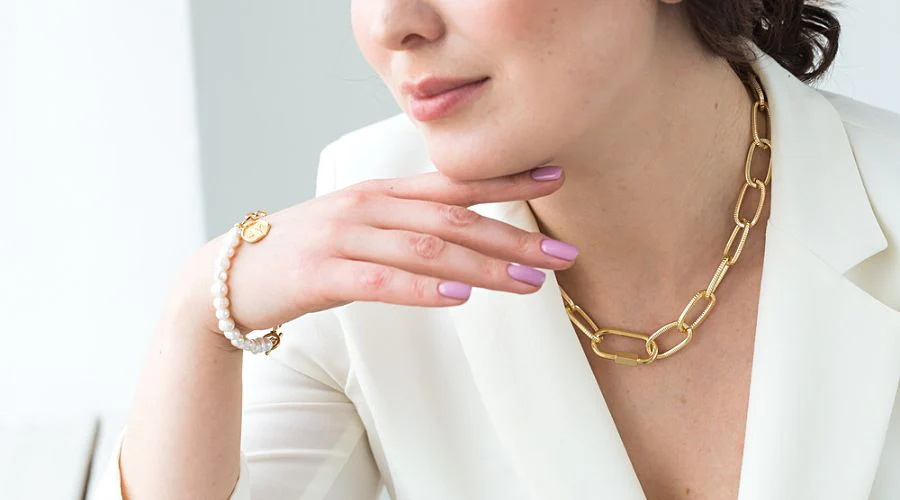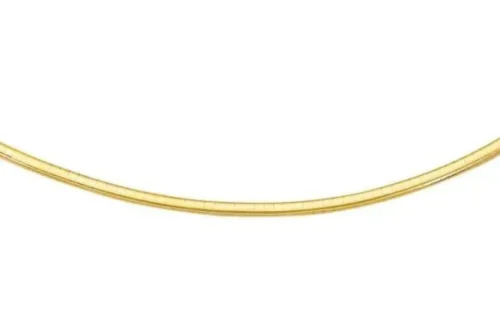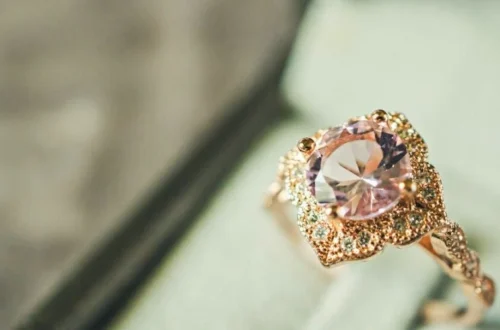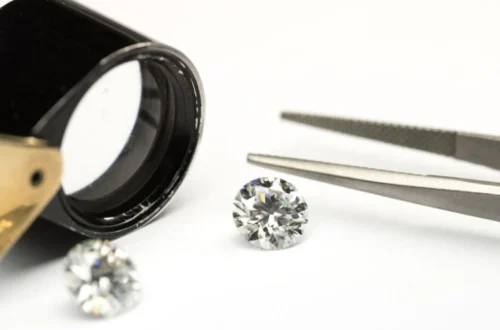Hypoallergenic Metals in Jewelry: Best Jewelry for Sensitive Skin
-
November 12, 2025
-
86
If you’re worried about wearing jewelry because of potential skin allergies, you’re not alone. Having a metal allergy creates a dilemma for people who want to wear necklaces, rings, and bracelets.
Thanks to hypoallergenic metals, people with metal allergies can enjoy jewelry, even the beautiful statement pieces. Learning how to identify safe metals helps you make informed choices about the jewelry you want to wear.
Hypoallergenic Metals & Allergy in Jewelry
Knowing what jewelry includes allergen-free metals makes wearing it more enjoyable.
What is Hypoallergenic Jewelry?
Hypoallergenic jewelry is free of nickel and copper. These two metals are the most common metal allergies. Manufacturers use nickel and copper to make alloys – a mixture of metals.
Alloys generally cost less than pure metals because they include inexpensive options like nickel and copper. When manufacturers add nickel, the alloy is less likely to corrode, so the jewelry doesn’t tarnish.
What is a Nickel Allergy?
People who are allergic to nickel tend to have allergic contact dermatitis. After coming into contact with nickel, allergy sufferers get an itchy rash.
Jewelry makers often use nickel in jewelry chains and findings. Nickel is in cell phones, laptops, eyeglass frames, detergents, and cosmetics. Keys, doorknobs, clothing buttons, and other products we use daily tend to have nickel in them.
Most people who have a nickel allergy aren’t born with the condition. It develops after a lifetime of exposure. Sadly, after developing the allergy, the problem does not go away.
Women more commonly have nickel allergies. Only 2% of men have an allergy to nickel, while 15% of women do.
Is Nickel-Free Important?
Most people can tolerate a small amount of nickel in their jewelry, but if you cannot, you should avoid wearing jewelry with trace amounts of metal. Unfortunately, the “nickel-free” label means the jewelry is not plated with nickel. However, the jewelry could have nickel in the metal itself.
If you have a skin reaction while wearing jewelry, you should see your dermatologist or allergist. They can do an allergy test to determine the severity of your allergy.
Other Types of Metal Allergies
Nickel isn’t the only metal that triggers allergies. Other metals, specifically copper, chromium, and cobalt, can trigger skin reactions. However, allergies to these metals are rare. Usually, jewelry labeled “hypoallergenic” means it has no nickel or a minute amount. Allergy-friendly jewelry could contain copper or other metals that trigger skin reactions.
Hypoallergenic Jewelry Metals

Fortunately, hypoallergenic metal options exist for people with sensitive skin.
Rhodium-Plated Sterling Silver
Pure sterling silver is generally allergy-free. When it is plated with rhodium, it is lustrous and safe to wear. It is a high-quality metal that does not tarnish and requires little care. However, the plating does wear out and might need replating.
Nickel-Free Sterling Silver
People who love to wear silver jewelry can find nickel-free silver in most jewelry shops and markets. The silver usually includes 92.5% silver with 7.5% copper. Occasionally, the alloy contains zinc or nickel. Unlike rhodium-plated sterling silver, nickel-free silver is prone to tarnishing. Wearing it will prevent tarnishing unless you have skin with more acid.
Platinum
If you love the look of silver and white gold but find it too much to manage, platinum jewelry is a good choice. This metal is made of ruthenium, iridium, and cobalt giving it a stunning luster that outshines sterling silver. The shine comes at a cost, as it is the most expensive metal used in jewelry today.
Platinum rarely causes contact dermatitis, but there have been rare occurrences where people develop rashes after wearing it. The purest and most abundant platinum is 195Pt, while the rarest is 190Pt.
Alternative Hypoallergenic Metals

People with metal allergies have several options that they may not have considered. You might not find these metals as readily available as platinum and sterling silver, but when you do, give them a try.
Aluminum
Aluminum is a lightweight metal that is easy to find and craft into beautiful jewelry. Jewelry makers can anodize it into several shiny colors. They can also use it to make large, statement pieces that are lighter than those made of silver or other metals.
Argentium silver
Argentium silver is a better quality metal than sterling silver. While sterling usually has a purity of 92.5%, Argentium silver must have at least 93.5% purity. It does not tarnish, so it is easier to maintain. It is always nickel-free and is a highly durable metal, making it a top choice for daily-wear jewelry.
Niobium
Niobium is an inert metal that is smooth, like titanium. It usually needs other metals added to it, because it is very soft. It can be anodized into colors.
Palladium
If platinum is out of your price range, try palladium. This new precious metal does not tarnish and has a purity rating of 95%. Palladium is so safe that dentists use it for implants. Car manufacturers use it to make catalytic converters, too.
Tantalum
Tantalum is a dense metal with outstanding corrosion resistance. It is commonly used in medical bone implants, as it is malleable, yet strong. It is rarely used in jewelry because it is a rare element.
Titanium
Titanium and tantalum are similar in their strength and durability. This natural element is non-toxic, corrosion-resistant, and biocompatible, making it hypo-allergenic. It’s a good choice for findings and daily-wear jewelry.
Other Metals Used in Jewelry

Some traditional metals are hypo-allergenic, while others can cause itchy skin reactions. It’s important to know which ones are safe to wear.
Brass
Because brass is made of copper and zinc, it can turn skin green. If you have any metal allergies, it’s a good choice to avoid wearing brass jewelry.
Bronze
Bronze is an alloy mixed with copper and tin. It might also contain nickel or aluminum. If you wear bronze, you might notice that it develops a green oxidation layer due to the copper content.
Copper
Like nickel, copper can cause skin reactions thanks to its chemical makeup. If you already have an allergy to nickel, you should avoid wearing copper jewelry, too. People with allergies are prone to developing more.
Gold
The only safe gold is 24 karat. When you buy gold with a lower karat rating, it could contain any compound mixture.
Pure silver
Pure silver is very soft, which is why most silver jewelry includes alloys. Sterling silver tarnishes because it usually has a bit of copper in it. To determine if you are buying sterling silver, look for the .925 mark on it.
Stainless steel
If you are buying stainless steel jewelry, look for options made with medical-grade stainless steel. It is usually labeled with the number 316. Most people do not react to stainless steel jewelry unless it includes small amounts of nickel.
Tungsten
Tungsten is a hard, tough, and heavy metal on the periodic table. Some tungsten jewelry is mixed with cobalt, which can trigger allergies. The metal is scratch-resistant, making it a popular choice for rings. Unfortunately, tungsten can include nickel.
Add timeless shine to any outfit with our elegant Gold Beaded Necklace — a modern classic for everyday luxury.
Vermeil
Gold vermeil is made with electrolysis. The jewelry is first made of a base metal, like silver. Then, the manufacturer uses electrolysis to apply a continuous coating of gold over the base metal. It is different from plating, as the gold layer can wear out. The best gold vermeil is 14k or 18k, but it could contain other metals, like nickel.
What to Do If You Are Allergic to Earrings or Other Metal Jewelry

If you find that you are allergic to your jewelry, contact your dermatologist or allergist. Stop buying cheap fashion jewelry as it usually contains the cheapest metals, like nickel.
Planning to Buy Hypoallergenic Jewelry?
When shopping for hypoallergenic jewelry, your safest bet is to buy pieces made with pure-grade metals. Read the labels and speak to the jewelers to determine what designs are safest for you.






Leave a comment